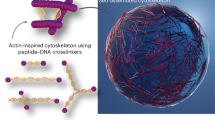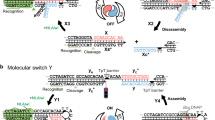Abstract
In multidimensional spectroscopy, dynamics of coherences between excited states report on the interactions between electronic states and their environment. The prolonged coherence lifetimes revealed through beating signals in the spectra of some systems may result from vibronic coupling between nearly degenerate excited states, and recent observations confirm the existence of such coupling in both model systems and photosynthetic complexes. Understanding the origin of beating signals in the spectra of photosynthetic complexes has been given considerable attention; however, strategies to generate them in artificial systems that would allow us to test the hypotheses in detail are still lacking. Here we demonstrate control over the presence of quantum-beating signals by packing structurally flexible synthetic heterodimers on single-walled carbon nanotubes, and thereby restrict the motions of chromophores. Using two-dimensional electronic spectroscopy, we find that both limiting the relative rotation of chromophores and tuning the energy difference between the two electronic transitions in the dimer to match a vibrational mode of the lower-energy monomer are necessary to enhance the observed quantum-beating signals.
This is a preview of subscription content, access via your institution
Access options
Access Nature and 54 other Nature Portfolio journals
Get Nature+, our best-value online-access subscription
$29.99 / 30 days
cancel any time
Subscribe to this journal
Receive 12 print issues and online access
$259.00 per year
only $21.58 per issue
Buy this article
- Purchase on Springer Link
- Instant access to full article PDF
Prices may be subject to local taxes which are calculated during checkout




Similar content being viewed by others
References
Brixner, T. et al. Two-dimensional spectroscopy of electronic couplings in photosynthesis. Nature 434, 625–628 (2005).
Tiwari, V., Peters, W. K. & Jonas, D. M. Electronic resonance with anticorrelated pigment vibrations drives photosynthetic energy transfer outside the adiabatic framework. Proc. Natl Acad. Sci. USA 110, 1203–1208 (2013).
Collini, E. et al. Coherently wired light-harvesting in photosynthetic marine algae at ambient temperature. Nature 463, 644–647 (2010).
Cho, M., Vaswani, H. M., Brixner, T., Stenger, J. & Fleming, G. R. Exciton analysis in 2D electronic spectroscopy. J. Phys. Chem. B 109, 10542–10556 (2005).
Cowan, M. L., Ogilvie, J. P. & Miller, R. J. D. Two-dimensional spectroscopy using diffractive optics based phased-locked photon echoes. Chem. Phys. Lett. 386, 184–189 (2004).
Brixner, T., Mančal, T., Stiopkin, I. V. & Fleming, G. R. Phase-stabilized two-dimensional electronic spectroscopy. J. Chem. Phys. 121, 4221–4236 (2004).
Mukamel, S. Principles of Nonlinear Optical Spectroscopy (Oxford Univ. Press, 1995).
Schlau-Cohen, G. S. et al. Elucidation of the timescales and origins of quantum electronic coherence in LHCII. Nat. Chem. 4, 389–395 (2012).
Fuller, F. D. et al. Vibronic coherence in oxygenic photosynthesis. Nat. Chem. 6, 706–711 (2014).
Romero, E. et al. Quantum coherence in photosynthesis for efficient solar-energy conversion. Nat. Phys. 10, 676–682 (2014).
Hayes, D., Griffin, G. B. & Engel, G. S. Engineering coherence among excited states in synthetic heterodimer systems. Science 340, 1431–1434 (2013).
Halpin, A. et al. Two-dimensional spectroscopy of a molecular dimer unveils the effects of vibronic coupling on exciton coherences. Nat. Chem. 6, 196–201 (2014).
Collini, E. & Scholes, G. D. Coherent intrachain energy migration in a conjugated polymer at room temperature. Science 323, 369–373 (2009).
Milota, F. et al. Vibronic and vibrational coherences in two-dimensional electronic spectra of supramolecular J-aggregates. J. Phys. Chem. A 117, 6007–6014 (2013).
Engel, G. S. et al. Evidence for wavelike energy transfer through quantum coherence in photosynthetic systems. Nature 446, 782–786 (2007).
Chin, A. W. et al. The role of non-equilibrium vibrational structures in electronic coherence and recoherence in pigment-protein complexes. Nat. Phys. 9, 113–118 (2013).
Christensson, N. et al. High frequency vibrational modulations in two-dimensional electronic spectra and their resemblance to electronic coherence signatures. J. Phys. Chem. B 115, 5383–5391 (2011).
Turner, D. B., Wilk, K. E., Curmi, P. M. G. & Scholes, G. D. Comparison of electronic and vibrational coherence measured by two-dimensional electronic spectroscopy. J. Phys. Chem. Lett. 2, 1904–1911 (2011).
Butkus, V., Zigmantas, D., Valkunas, L. & Abramavicius, D. Vibrational vs. electronic coherences in 2D spectrum of molecular systems. Chem. Phys. Lett. 545, 40–43 (2012).
Chin, A. W., Huelga, S. F. & Plenio, M. B. Coherence and decoherence in biological systems: principles of noise-assisted transport and the origin of long-lived coherences. Phil. Trans. R. Soc. Lond. A 370, 3638–3657 (2012).
Tiwari, V., Peters, W. K. & Jonas, D. M. Energy transfer: vibronic coherence unveiled. Nat. Chem. 6, 173–175 (2014).
Chenu, A., Christensson, N., Kauffmann, H. F. & Mančal, T. Enhancement of vibronic and ground-state vibrational coherences in 2D spectra of photosynthetic complexes. Sci. Rep. 3, 2029 (2013).
Lim, J. et al. Vibronic origin of long-lived coherence in an artificial molecular light harvester. Nat. Commun. 6, 7755 (2015).
Singh, V. P. et al. Towards quantification of vibronic coupling in photosynthetic antenna complexes. J. Chem. Phys. 142, 212446 (2015).
Blankenship, R. E. Molecular Mechanisms of Photosynthesis (Blackwell Science, 2002).
Van Amerongen, H. Photosynthetic Excitons (World Scientific, 2000).
Bixner, O. et al. Ultrafast photo-induced charge transfer unveiled by two-dimensional electronic spectroscopy. J. Chem. Phys. 136, 204503 (2012).
Prall, B. S., Parkinson, D. Y., Ishikawa, N. & Fleming, G. R. Anti-correlated spectral motion in bisphthalocyanines: evidence for vibrational modulation of electronic mixing. J. Phys. Chem. A 109, 10870–10879 (2005).
Jumper, C. C. et al. Intramolecular radiationless transitions dominate exciton relaxation dynamics. Chem. Phys. Lett. 599, 23–33 (2014).
Cho, S. et al. Coherence in metal−metal-to-ligand-charge-transfer excited states of a dimetallic complex investigated by ultrafast transient absorption anisotropy. J. Phys. Chem. A 115, 3990–3996 (2011).
Sparano, B. A., Shahi, S. P. & Koide, K. Effect of binding and conformation on fluorescence quenching in new 2′,7′-dichlorofluorescein derivatives. Org. Lett. 6, 1947–1949 (2004).
Cheng, Y.-C. & Fleming, G. R. Dynamics of light harvesting in photosynthesis. Annu. Rev. Phys. Chem. 60, 241–262 (2009).
Scholes, G. D., Fleming, G. R., Olaya-Castro, A. & van Grondelle, R. Lessons from nature about solar light harvesting. Nat. Chem. 3, 763–774 (2011).
Cheng, Y.-C., Engel, G. S. & Fleming, G. R. Elucidation of population and coherence dynamics using cross-peaks in two-dimensional electronic spectroscopy. Chem. Phys. 341, 285–295 (2007).
Hybl, J. D., Albrecht Ferro, A. & Jonas, D. M. Two-dimensional Fourier transform electronic spectroscopy. J. Chem. Phys. 115, 6606–6622 (2001).
McClure, S. D., Turner, D. B., Arpin, P. C., Mirkovic, T. & Scholes, G. D. Coherent oscillations in the PC577 cryptophyte antenna occur in the excited electronic state. J. Phys. Chem. B 118, 1296–1308 (2014).
Turner, D. B. et al. Quantitative investigations of quantum coherence for a light-harvesting protein at conditions simulating photosynthesis. Phys. Chem. Chem. Phys. 14, 4857–4874 (2012).
Womick, J. M. & Moran, A. M. Exciton coherence and energy transport in the light-harvesting dimers of allophycocyanin. J. Phys. Chem. B 113, 15747–15759 (2009).
Lozovoy, V. V., Pastirk, I. & Dantus, M. Multiphoton intrapulse interference. IV. Ultrashort laser pulse spectral phase characterization and compensation. Opt. Lett. 29, 775–777 (2004).
Acknowledgements
The authors thank P. Dahlberg for useful discussions. L.W., G.B.G., A.Z. and G.S.E. thank the Defense Threat Reduction Agency (Grant No. HDTRA1-10-0091), Air Force Office of Scientific Research (Grant No. FA9550-14-1-0367), Defense Advanced Research Projects Agency QuBE (Grant No. N66001-10-1-4060), National Science Foundation (NSF) MRSEC Program (Grant No. DMR 14-20709), Vannevar Bush Fellowship (ONR N00014-16-1-2513), the Alfred P. Sloan Foundation and the Camille and Henry Dreyfus Foundation for support. R.F.J. and F.Z. acknowledge support from the NSF (Grant Nos. CHE-0911180 and CHE-1048528).
Author information
Authors and Affiliations
Contributions
L.W., G.B.G., A.Z., F.Z. and G.S.E. designed the experiment. L.W., A.Z. and F.Z. performed the synthesis and characterization. L.W. and G.B.G. performed the measurements. L.W. and N.E.W. analysed the data. L.W., G.B.G. and G.S.E. wrote the manuscript, with input from all authors. G.S.E. and R.F.J. supervised the project.
Corresponding author
Ethics declarations
Competing interests
The authors declare no competing financial interests.
Supplementary information
Supplementary information
Supplementary information (PDF 24315 kb)
Rights and permissions
About this article
Cite this article
Wang, L., Griffin, G., Zhang, A. et al. Controlling quantum-beating signals in 2D electronic spectra by packing synthetic heterodimers on single-walled carbon nanotubes. Nature Chem 9, 219–225 (2017). https://doi.org/10.1038/nchem.2729
Received:
Accepted:
Published:
Issue Date:
DOI: https://doi.org/10.1038/nchem.2729
This article is cited by
-
Two-dimensional electronic spectroscopy
Nature Reviews Methods Primers (2023)
-
Quantum coherences reveal excited-state dynamics in biophysical systems
Nature Reviews Chemistry (2019)
-
Resonance is the key for coherence
Nature Chemistry (2017)



